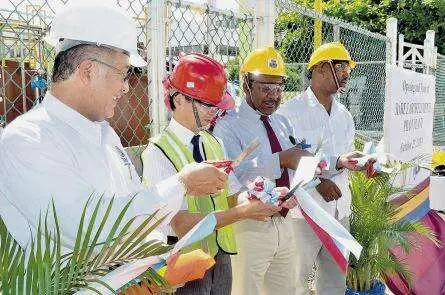
A rare find
JAPANESE firm Nippon Light Metals Company yesterday revealed that its motivation in spearheading the US$5-million rare earth elements pilot project with the Government of Jamaica is to try to break China’s hold on the market.
Operations manager for the project, Tsuyoshi Kawarasaki, told the Jamaica Observer at the opening of the pilot plant yesterday that, given the higher concentration of rare earth elements in Jamaica’s red mud deposits compared to global competitors, the island held the key to making Nippon’s goal a reality.
“The Jamaican red mud is very excellent compared to the other red mud all over the world, so we chose Jamaican bauxite,” he said.
Some 17 rare earth elements — including scandium, yttrium, cerium and erbium — are to be found in red mud, but Nippon’s target, Kawarasaki said, is dysprosium (Dy) which is found in large quantities in China and used in the manufacture of lasers and magnets.
“Our target is Dy, a material or manganate only found in China. China is controlling the market, so we must compete with them,” he said.
Kawarasaki declined to say much else, repeating what Rare Earth Elements steering committee member and executive director of the Jamaica Bauxite Institute (JBI) Dr Parris Lyew-Ayee, as well as mining and energy minister Phillip Paulwell said earlier: That the process was not yet patented, and so was a tightly kept secret.
The media found this out the hard way, as, though invited to tour the much talked-about facility, the members were later denied the opportunity with the explanation that the equipment and processes were being guarded in order to protect the intellectual property of the project.
“This is a very important milestone in the development of the bauxite resource in Jamaica,” Lyew-Ayee explained yesterday.
“There are other processes of extracting rare earth from different types of rocks and sources. However, extraction from red mud has never been done before in any commercial quantities. This is a first. Everything here you see is prototype, and
as such the sensitivity of the project is very important for us,” he added.
The plant, sited at the Jamaica Bauxite Institute (JBI) at Hope Gardens in St Andrew, will begin operation at the end of the month, with the pilot project set to last until February or March next year. It is a month behind schedule, arising from delays in the shipment of some equipment, and with the procurement of building contractors, but the partners remain excited at
the prospects.
“Last year we visited Nippon Light’s [laboratory] in Japan and saw them working on rare earth minerals from our red mud, and we were very pleased with what we saw there. What I’m seeing here now is about 10 times the scope of what they were doing in Japan and I am very, very impressed,” said Paulwell.
“I now understand why it is $500 million that’s been spent so far, and I believe that this is going to represent a tremendous project for Jamaica. The Ministry of Science, Technology, Energy, and Mining is pleased and proud that we are fostering this kind of development in Jamaica,” he told journalists.
“I also saw the early stages in Japan, and it was nothing like this,” Lyew-Ayee added.
Explaining the process in non-technical terms, Kawarasaki said dried red mud from Windalco’s Kirkvine works is transported to the JBI and stored in an area that has a capacity of 30 tonnes. It is then conveyed into huge tanks where it is mixed with water to create a controlled concentration. In the second stage, sulphuric acid is used to leach
the red mud before the rare elements are extracted, in phase three. Next, is separation and purification of the target element, then the waste, a reddish coloured water which the scientists
say is neutralised, is channelled to a pond.
If commercialisation proves to be viable, Dr Lyew-Ayee said the plan is not just to extract the oxide and export it to Japan.
[It is] to get the value-added products as far down as we can in Jamaica, which would mean more jobs, more industry, more support services that would support a brand new industry that would be adjunct to the bauxite and alumina industry.
For now, though, the focus is on answering critical questions.
“All the equipment inside there is brand new. This has never been done before, so we need to know how will they stand up under pressure, under the quantities we’re talking about? How will the process work, how efficiently will it work? said Lyew-Ayee.
“How do we maximise the efficiency of the process while minimising the cost to be able to get the benefits coming out?”
He added: “The chemistry and the science is all good, all pointing in the right direction, but how do you translate it into business? That’s what this is about and you don’t want to make the mistakes in a full plant. That’s what the pilot plant is for.
Paulwell said the Government has “tremendous hope for the realisation of a fully commercialised product, and we believe that this pilot plant will prove it”.
Rare earth elements, in general, are used in the manufacture of high-tech gadgets and equipment such as smartphones, plasma screens, DVDs, rechargeable batteries, digital cameras, hybrid cars, wind turbines, and satellites.

























